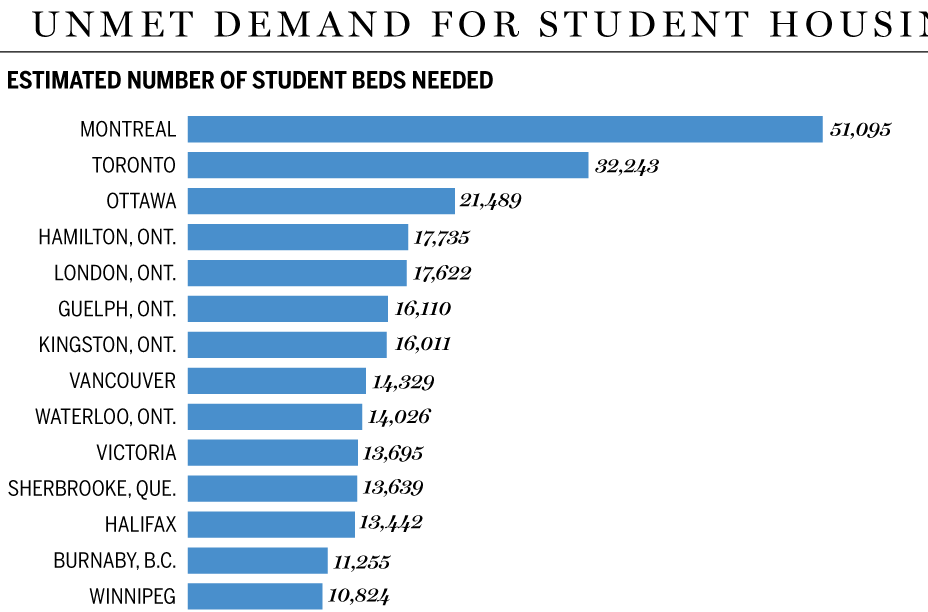Haider-Moranis Bulletin: The private sector can develop student housing into a mature class of real estate investments
As enrolment at Canada’s universities and colleges continues to grow, the space for lecture halls, labs and academic offices is becoming scarcer. The same goes for on- and off-campus student housing.
More than 1.5 million full-time students are currently enrolled in Canadian universities and colleges. They collectively generate a huge demand for rental housing and, in particular in large urban centres where rents are high, present a predictable source of demand for rental units.
But these days, students aren’t the only ones with an interest in student housing.
The previously ignored sector has become a niche opportunity for investors as well, lured by yields that U.K.-based real estate services provider Savills notes are “currently higher than in many sectors.”
Earlier this year, the Canada Pension Plan Investment Board (CPPIB) announced that their joint venture, Scion Student Communities, acquired a student housing portfolio worth US$1.1 billion. The portfolio comprises 13,666 beds in 20 university campus markets across the U.S.
A recent report in the Economist revealed that student housing attracted US$16 billion worldwide investment in 2016, as sovereign wealth funds increasingly target the sector.

Opportunity exists in Canada as well. The growth in the number of post-secondary students here has not been met with a commensurate increase in student-centric housing. The need is most acute in cities such as Toronto, where a collaborative initiative, StudentDwellTO — sponsored by the presidents of the four Toronto universities — aims to find solutions for student housing challenges.
While universities may be tempted to secure a larger piece of the student housing pie by getting more involved themselves, that would be a mistake. Universities are in the business of education and not running rental accommodation. They should encourage and facilitate the private sector, which has the experience and the resources to help the hitherto nascent student housing market reach maturity in Canada.
SVN Rock Advisors Inc. Brokerage specializes in student housing finance. They estimate that the unmet (residual) demand for student housing in Canada is more than 416,000 beds. This should hardly come as a surprise since even with millions enrolled in Canadian universities, the total number of on-campus beds is just 121,164.
SVN estimates that the current number of purpose-built off-campus beds across Canada is 39,178, almost half of which are in the Kitchener-Waterloo area.
The unmet demand for such housing is estimated to be huge, with 51,000 beds needed in Montreal, 32,000 in Toronto and 21,500 in Ottawa.
From an investment point of view, the numbers favour student housing over other residential rental projects. For instance, a purpose-built rental with 140,000 square feet of rental space can house approximately 220 people in 140 units. The same space will accommodate 450 students and can generate 30 per cent more rent, says Derek Lobo, who heads SVN.
And the demand for student housing in Canada is only expected to rise. The demographic realities of most regions of Canada and the increased appetite for education around the world mean that international students will comprise a larger proportion of university enrolments in the future.
During 2011-12 and 2015-16, the number of full-time Canadian students enrolled in Bachelor’s or equivalent programs increased by only two per cent. In comparison, the number of international students studying in Canada increased by a whopping 52 per cent. In Manitoba and British Columbia, the comparable international student population grew by 88 per cent and 74 per cent respectively.
As Canadian universities compete globally to attract international students, they must recognize that “residence life” is very much part of the educational experience. As universities specialize in the delivery of educational services, they should collaborate with private sector investors and property managers to provide quality housing services.
The days of ageing, run-down student housing are over. Students and their parents expect and demand quality housing. Given a stable source of demand and the willingness to pay, the private sector can develop student housing into a mature class of real estate investments.




 Maziar Moini, Broker of Record - Home Leader Realty Inc.
300 Richmond St. W., #300, Toronto, ON M5V-1X2
Maziar Moini, Broker of Record - Home Leader Realty Inc.
300 Richmond St. W., #300, Toronto, ON M5V-1X2

